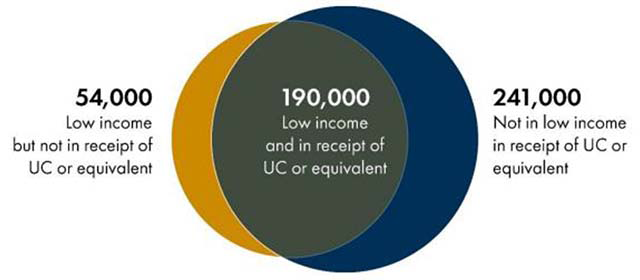Scottish Child Payment and the labour market
This publication presents Scottish Government analysis of how Scottish Child Payment interacts with the labour market in Scotland including how it impacts labour market decisions of its clients.
Poverty
23. Latest Scottish Government poverty statistics published in March 2024 show 26% of children in Scotland lived in households in relative poverty in 2022-23[11]. This is an increase of 3 percentage points from the year before (23% in 2021-22). The Scottish Government’s interim child poverty target is to reach below 18% of children in Scotland living in households in relative poverty in 2023-24.
24. Scottish Government analysis[12] published in February 2024 projects relative child poverty would be 6 percentage points higher in Scotland in 2024-25 in the absence of SCP. This equates to keeping around 60,000 children across Scotland out of relative poverty that year.
25. The same analysis projects Scottish Government policies overall will keep around 100,000 children in Scotland out of relative poverty in 2024-25, and the relative child poverty rate 10 percentage points lower than it otherwise would be.
26. Analysis published by the Scottish Parliament Information Centre (SPICE) sets out estimates of overlaps and gaps in children in households in poverty and receipt of benefits in Scotland. See Figure 1.

Source: SPICE briefing, Social Justice and Social Security Committee 16th meeting, May 2024.
27. This analysis is based on Households Below Average Income (HBAI) data for Scotland and adjusts for the under-reporting of benefit receipt in the Family Resources Survey (where the HBAI data originates from) and estimates around half of children on UC in Scotland are not in relative poverty (241,000 out of 431,000). However, some of those children defined as living in households not in poverty in Scotland will have been lifted out of poverty by SCP.
28. SPICE also estimates around a fifth of children in poverty may not be in receipt of UC or equivalent benefits (54,000 out of 244,000), and that much of this might be explained by UC non take-up – families eligible for UC but who do not apply for it, with a small proportion possibly explained by people who are not eligible for UC – e.g. some parent students and those with no recourse to public funds. Anyone not in receipt of UC or an equivalent benefit would not be eligible for SCP.
29. This analysis demonstrates that some families receiving SCP will not be in poverty and some families in poverty will not be receiving SCP. However, some of those defined as not in poverty will move in and out of poverty over time and even when above the poverty line households can face significant financial challenges and be close to poverty thresholds. Poverty indicators are also income rather than needs based and aside from housing costs do not consider day to day costs incurred by households. All SCP clients are in low income households by virtue of qualifying for underlying means tested benefits (e.g. UC) and could be considered either in poverty or at risk of moving into poverty.
Contact
Email: Dominic.Mellan@gov.scot
There is a problem
Thanks for your feedback